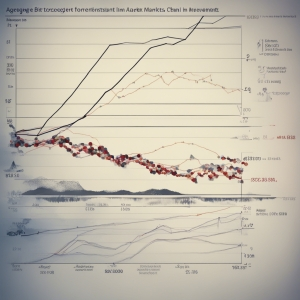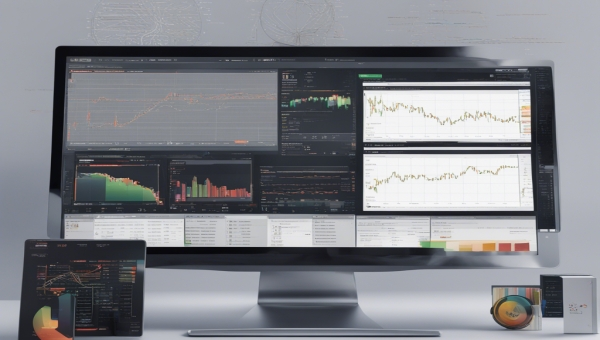Table of Contents:
Introduction to On-Chain Metrics
Having a clear grasp of what we commonly refer to as 'on-chain metrics' is vital for anybody interested in the art of cryptocurrency trading. On-chain metrics are transaction data and statistics that happen directly on the blockchain. They are invaluable in predicting market movements, helping traders make informed decisions on when to buy and sell. This dynamic data includes transaction volume, active addresses, and even the number of coins held by whales.
On-chain metrics offer a glimpse into the detailed workings of cryptocurrencies, enhancing understanding, and providing an edge for investors. They help predict the market behaviours and follow the patterns of significant market players. Proper understanding of these metrics can make the difference between poor and strategic trading decisions.
Crucially, On-Chain Metrics Prediction allows investors to get a clearer picture of the real demand for a particular cryptocurrency, independent of what the market price might suggest. Hence, it provides an extra layer of insight that can be instrumental in successful trading.
Understanding the Power of On-Chain Metrics
On-chain metrics provide data that is free from manipulation, reflecting the true state of a cryptocurrency's usage and value. This data includes aspects like the number of daily transactions, the size of these transactions, the number of active addresses, and more. By analyzing these factors, traders can enhance their understanding of the market and make more accurate predictions.
One key metric to look at is the transaction volume, which provides insight into a crypto's popularity and demand. A high transaction volume is often a sign of healthy market activity, indicating that a cryptocurrency is frequently being bought and sold.
Another essential metric is the number of active addresses. An increase in the number of active addresses usually signals a rising interest in the cryptocurrency, potentially signalling a trend towards an increase in price.
Finally, there's the number of coins held by whales – large investors or entities who own a significant percentage of a cryptocurrency. This metric can give traders a sense of the market's liquidity and the potential for large price swings.
Pros and Cons of Using On-Chain Metrics for Predicting Market Movements
| Pros | Cons |
|---|---|
| On-chain metrics offer real-time insight into trading behavior. | Multiple elements can impact the market making predictions solely based on on-chain data potentially misleading. |
| An increase in blockchain activity may indicate market enthusiasm. | Without off-chain data, it can be challenging to interpret why the blockchain activity is increasing. |
| On-chain metrics may be useful in predicting long-term market trends. | Not all cryptocurrencies have enough on-chain data to make accurate predictions. |
Analyzing Market Movements through On-Chain Metrics

Breaking down the market movements using on-chain metrics prediction may feel like a daunting task at first, especially for those new to the cryptocurrency world. However, with a little time and patience, it can become a potent tool in your trading arsenal.
A vital step is to understand the correlation between the metrics and the price. For example, a sudden spike in transaction volume, coupled with an increased number of active addresses, might suggest an upcoming price surge. On the other hand, a significant accumulation of coins by whales could signal an upcoming price drop as big players prepare to sell.
Various online platforms offer tools to track these metrics in real-time. These platforms provide a comprehensive overview, allowing you to see the big picture and fine-tune your trading strategy accordingly. In addition, it's always essential to remember to weigh on-chain metrics alongside other market indicators. This way, you can balance your approach and avoid relying on a single metric.
Drawing conclusions based on on-chain metrics is part art and part science. It's about sifting through the noise and focusing on the data that reflects the genuine demand and interest in a cryptocurrency. Making this distinction is what sets savvy traders apart. Indeed, becoming proficient in on-chain metrics prediction is an investment in itself, but one that can yield significant returns in the long run.
Predicting Market Trends with On-Chain Metrics
Mastering the use of on-chain metrics certainly takes you a step further into smart cryptocurrency trading. These characteristics act as the underlying signals for predicting future market trends, providing a clear view of an otherwise complicated scenario.
One systematic way to leverage this is by monitoring 'whale movements'. This means observing how much of a particular cryptocurrency is moved to and from wallet addresses that hold large quantities. Such details often provide a hint about imminent price movements, as these significant amounts can directly impact market dynamics.
Metrics related to network usage, such as the number of transactions or active addresses, also play a critical role in estimating market sentiment. An increase in these numbers usually means more people are using the said cryptocurrency, signifying growing popularity.
Similarly, the 'hash rate', or computational power used in the network, can suggest changes in cryptocurrency security and price volatility. A higher hash rate means better network security and lower chances of sell-offs, leading to stable or increasing prices.
Remember, though, while using on-chain metrics for prediction, it's important not to base your decisions on a single metric. Instead, consider them as part of a wider pool of factors influencing the market. Pairing on-chain data with other forms of technical and fundamental analysis can lead to more rounded, reliable results. By interpreting these signals correctly, you can position your portfolio to capitalize on potential market movements in advance.
Interpreting On-Chain Metrics for Successful Investment

The first step towards interpreting on-chain metrics effectively is gaining familiarity with what each metric measures. An essential identification in this measure is differentiating between the address and the entity. An entity can control several addresses, so simply counting the number of addresses can lead to misguided assumptions. Therefore, having a clear understanding of this difference is vital in interpreting the data accurately.
Being aware of fluctuations in transaction volume provides a significant advantage in reading market trends. In situations where transaction volume rises while the price falls, it could signal a buying opportunity as the market is still fundamentally strong. Simultaneously, a decrease in transaction volume might indicate a lesser interest, resulting in the price dropping.
Daily active addresses are another useful metric, showcasing the number of unique addresses involved in transactions on a given day. If this number increases, it could lead to a likely increase in demand and, subsequently, the price of crypto.
Lastly, understanding the metrics pertaining to large crypto holders, known as whales, is crucial. If the amount of a particular cryptocurrency held by whales is increasing, it might indicate a rise in price soon.
On-chain metrics provide a data-driven lens to assess and predict market movements. By interpreting these metrics critically and holistically, traders can gain a trading advantage and potentially enjoy significant investment success.
On-Chain Metrics: Your Financial Radar
Think of on-chain metrics as a financial radar system. They provide valuable data that can help clarify the often cloudy cryptocurrency market landscape. The beauty of on-chain metrics lies in their immutability and transparency. Any transaction that takes place on a blockchain cannot be altered, making the data trustworthy and reliable.
These metrics serve as factual indicators, setting apart the hype from the reality in the digital currency world. They provide an accurate picture of the economic activity occurring within a given blockchain network. Comprehending these metrics allows traders to anticipate possible future market behavior and adjust their trading approach accordingly.
Whether it’s spotting an unusual increase in transaction volume or observing the frequency of small vs large transactions, every piece of data can prove valuable. Similarly, understanding the movement of coins between wallets can help indicate potential market swings based on the trading behavior of whales. It provides an opportunity to align your trading strategy with prevailing market trends.
In short, on-chain metrics act as a financial radar, picking up signals and patterns that might be invisible to the naked eye. Leveraging these tools can enhance your trading strategies and provide a competitive edge in the complex world of crypto trading.
Conclusion: The Future of On-Chain Metrics in Market Prediction

As we've explored in this article, on-chain metrics hold a powerful position in the realm of cryptocurrency trading. They offer a transparent and substantial look at real-time transactional data, opening a world of opportunities for predicting market movements.
By understanding and decoding the data provided by on-chain metrics, traders can make forecasting market trends a less daunting task. They can not only monitor market activity but also predict price fluctuations and strategize their investments wisely. The use of these metrics is becoming increasingly significant in enhancing the accuracy and profitability of traders' strategies.
Furthermore, as blockchain technology advances and cryptocurrency markets continue to mature, the role of on-chain metrics in predicting market movements is expected to become even more prominent. The future will potentially see the development of new metrics, providing an even deeper understanding of the market.
The path of cryptocurrency trading is poised to be smoother and more precise with the onset of thorough analysis using on-chain metrics. Armed with this knowledge, traders are bound to navigate the dynamic landscapes of digital assets with much more confidence and skill. Remember that although these metrics are a powerful tool, they should be utilized in conjunction with a comprehensive and balanced trading strategy.
Key On-Chain Metrics to Watch
When delving into the world of cryptocurrencies and on-chain metrics, there are a few key metrics that you should keep your eye on. These include the Hash Rate, the NVT Ratio, and the MVRV Ratio.
The Hash Rate is a measure of the processing power of the Bitcoin network. It shows how much computing power is being used to keep the network secure. When the hash rate is high, it generally indicates that the network is strong, secure, and growing. A sudden drop in hash rate might indicate less mining activity, which could affect the network's security and transaction speed.
The NVT Ratio (Network Value to Transactions Ratio) compares the value of the cryptocurrency's transaction activity relative to its market cap. It’s a valuation indicator to detect whether a cryptocurrency is overvalued or undervalued. A high NVT ratio might suggest that the coin is overvalued relative to its economic activity and could be overpriced.
The MVRV Ratio (Market Value to Realized Value) on the other hand, compares the market value of a cryptocurrency to the value of the coins that have been moved in the last 30 days. This ratio can signal periods of over- or under-valuation. A high MVRV ratio suggests that traders are up significantly on their initial investment and may be looking to sell, potentially leading to a price correction.
Keeping an eye on these metrics can give you a clearer understanding of the market's behavior and help you make better-informed trading decisions.
FAQ: Understanding On-Chain Metrics in Crypto Market Prediction
What are On-Chain Metrics?
On-Chain metrics are blockchain data points, which provide insightful information about transaction volume, network usage, and other activities happening on a blockchain network like Bitopex.
How do On-Chain Metrics predict market movements?
On-Chain Metrics analyze the overall health of a blockchain network by tracking transactions and wallet activities. Significant fluctuations in these metrics can indicate potential market movements.
What is the Role of Bitopex in Understanding On-Chain Metrics?
Bitopex provides a platform where users can access real-time On-Chain Metrics. This data helps users make informed trading decisions based on blockchain activity.
Which On-Chain Metrics Are Most Important For Predicting Market Movements?
Active addresses, transaction volume, and the number of transactions per block are some of the most important On-Chain Metrics for predicting market movements.
Are On-Chain Metrics foolproof in predicting market behaviors?
While On-Chain Metrics provide valuable insights, they do not guarantee accurate market predictions. They should be used in conjunction with other technical and fundamental analysis tools.




